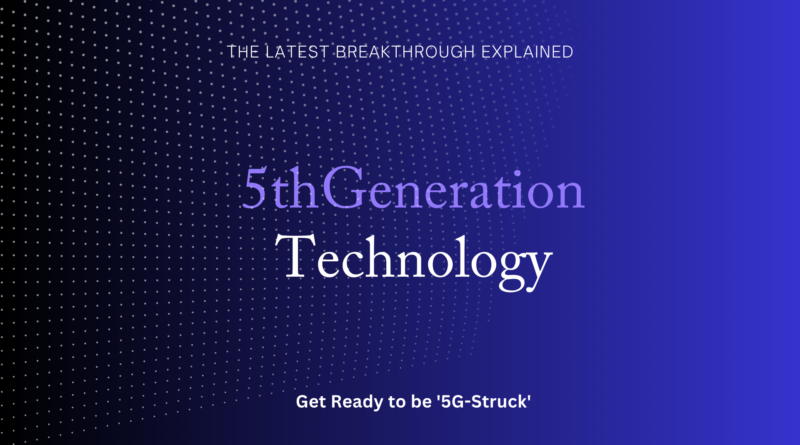Unleashed the Power of 5G: Transforming Industries and Improving Lives
As the world embraces the era of 5G and next-generation connectivity, the potential for innovation and transformation across various industries becomes increasingly apparent. This paper explores the revolutionary impact of 5G technology and its role in shaping the future of connectivity. By examining key areas such as healthcare, transportation, entertainment, smart cities, and remote work, we delve into the innovative and engaging applications that leverage 5G and propel us toward a more connected and advanced society.
Introduction: Unveiling the 5G Frontier
As the world ushers in the era of 5G, we witness a paradigm shift in connectivity that goes beyond faster speeds and lower latency. 5G technology encompasses a spectrum of cutting-edge advancements, including massive machine-type communications, ultra-reliable low-latency communications, and enhanced mobile broadband. These advancements will empower industries and individuals, fueling innovation and revolutionizing the way we live, work, and interact. Let’s uncover the potential of 5G technology and its defining characteristics. Explore the importance of next-generation connectivity in fostering innovation and driving progress.

Revolutionizing Healthcare: Pioneering a New Era of Care
The healthcare industry stands to gain immensely from the capabilities of 5G technology. Telemedicine is a prime example of how 5G enables remote patient care, facilitating virtual consultations, monitoring patients in real-time, and offering vital healthcare services to underserved areas. With high-speed connections, healthcare professionals can conduct detailed remote examinations, share medical imaging data seamlessly, and provide timely and accurate diagnoses.
Moreover, 5G’s impact on healthcare extends to surgical training and patient care. Surgeons can leverage augmented reality (AR) and virtual reality (VR) technologies to simulate complex procedures, improving precision and reducing risks. For patients, these immersive technologies enhance pre-operative planning, allowing them to better understand their conditions and make informed decisions.
Additionally, the Internet of Things (IoT) combined with 5G enables a new era of personalized healthcare. Connected devices and wearables can continuously monitor vital signs, track medication adherence, and provide real-time health data to healthcare professionals. This proactive approach to healthcare empowers individuals to take control of their well-being and enables early detection and intervention in disease management.
Transforming Transportation: Driving the Future of Mobility
Explore how 5G is reshaping the transportation industry. Discover the potential of intelligent transportation systems for safer and more efficient traffic management. Learn about vehicle-to-vehicle (V2V) and vehicle-to-infrastructure (V2I) communication, powering the future of autonomous driving. Delve into enhanced in-car entertainment and immersive experiences during travel.
Enhanced Vehicle Connectivity: 5G enables seamless and high-speed connectivity for vehicles, allowing them to communicate with each other and with surrounding infrastructure in real time. This connectivity creates a foundation for advanced driver-assistance systems (ADAS), cooperative intelligent transportation systems (C-ITS), and autonomous vehicles. With 5G, vehicles can exchange critical data such as traffic conditions, road hazards, and sensor information, leading to improved safety, efficiency, and overall driving experience.

V2X Communication: Vehicle-to-everything (V2X) communication, a key component of smart transportation systems, benefits greatly from 5th generation technology. 5G enables low-latency, high-capacity, and reliable communication between vehicles, pedestrians, traffic lights, and other road infrastructure. This communication facilitates various applications, including collision avoidance, cooperative platooning, and intersection management. By leveraging 5G’s capabilities, V2X communication enhances road safety, optimizes traffic flow, and reduces congestion.
Intelligent Traffic Management: 5th Generation plays a crucial role in enabling intelligent traffic management systems. With its high data transmission speeds and low latency, 5G allows traffic authorities to collect and process vast amounts of real-time data from sensors, cameras, and connected vehicles. This data can be used to monitor and analyze traffic patterns, predict congestion, and dynamically adjust traffic signals and routes. As a result, 5G-powered intelligent traffic management systems can optimize traffic flow, reduce travel time, and minimize environmental impact.
Enriching Entertainment: Where Boundless Possibilities Unfold
5G brings a paradigm shift to the world of entertainment, delivering unparalleled experiences and unlocking boundless possibilities. Ultra-high-definition (UHD) streaming becomes a seamless reality with 5G’s increased bandwidth and lower latency, allowing users to indulge in crystal-clear visuals and immersive audio. Whether it’s streaming movies, TV shows, or live sports events, it ensures uninterrupted, high-quality content delivery.
Moreover, virtual reality (VR) and augmented reality (AR) technologies take center stage with 5G’s capabilities. VR immerses users in lifelike virtual environments, providing an unparalleled level of engagement and interactivity. From gaming to educational experiences, 5G-powered VR opens up new dimensions of entertainment and learning. AR, on the other hand, blends the virtual world with the real world, enhancing live events
Building Smart Cities: Forging the Cities of Tomorrow
The concept of smart cities revolves around leveraging advanced technologies to optimize resource management, enhance sustainability, and improve the quality of life for citizens. 5th generation technology plays a pivotal role in building smart cities by providing the necessary connectivity and infrastructure to power a myriad of IoT devices and applications.
One of the key components of smart cities is the integration of IoT-powered infrastructure. With 5G connectivity, a vast network of sensors, devices, and machines can seamlessly communicate and share data in real-time. This enables efficient resource management across various domains, such as energy, water, waste management, and transportation.
In the realm of energy, smart grids equipped with IoT sensors and 5G connectivity can optimize energy distribution, monitor consumption patterns, and detect faults promptly. This results in reduced energy waste, lower costs, and increased sustainability. Furthermore, real-time data analytics allow for proactive load balancing, integrating renewable energy sources, and responding to fluctuations in energy demand.
Similarly, water management systems benefit from 5G-powered IoT devices that enable accurate monitoring of water levels, quality, and consumption. The data collected facilitates predictive analytics, enabling early leak detection, optimizing water distribution, and promoting conservation efforts.
Waste management becomes more efficient with 5G-enabled smart city solutions. Waste bins equipped with IoT sensors can transmit real-time data about their fill levels, enabling optimized waste collection routes, reducing unnecessary trips, and minimizing environmental impact. Furthermore, smart sorting systems utilize AI and machine learning algorithms to automate waste segregation, improving recycling rates and promoting a circular economy.
Smart transportation is another domain where 5th generation enabled IoT infrastructure makes a significant impact. Traffic management systems equipped with real-time data from sensors and connected vehicles can dynamically adjust traffic signals, optimize traffic flow, and reduce congestion. Additionally, smart parking solutions leverage 5G connectivity to provide real-time information on available parking spaces, reducing traffic congestion and carbon emissions caused by drivers searching for parking spots.
In the pursuit of sustainability, smart grids are instrumental in optimizing energy usage and promoting renewable energy integration. 5G technology provides the essential connectivity for smart grids, enabling seamless communication between energy providers, consumers, and the grid itself.
With 5G-enabled smart grids, energy providers can monitor and manage energy distribution in real-time, responding to changes in demand and supply more efficiently. This flexibility allows for the integration of intermittent renewable energy sources, such as solar and wind, into the grid. Real-time data analytics and predictive algorithms facilitate demand-response mechanisms, where energy consumption can be adjusted during peak hours to balance the grid load and reduce strain on the system.
Empowering Remote Work: Redefining Productivity and Collaboration
In recent years, the concept of remote work has gained significant traction, and the COVID-19 pandemic further accelerated its adoption across various industries. As organizations adapt to this new paradigm, the need for reliable and high-speed connectivity has become paramount. This is where the power of 5G technology comes into play, revolutionizing remote work environments and redefining productivity and collaboration.
One of the key advantages of 5G is its ability to provide ultra-fast and low-latency connectivity. With speeds that surpass those of traditional networks, remote workers can now enjoy seamless communication and collaboration experiences. Video conferencing, file sharing, and real-time collaboration on projects become more efficient and productive with the enhanced network capabilities of 5G.
Furthermore, the reliability of 5G ensures that remote workers can consistently stay connected and engaged. No longer will they have to worry about dropped calls, frozen screens, or sluggish internet speeds. This level of connectivity empowers professionals to work from anywhere, whether it’s a home office, a coworking space, or even a coffee shop.
Augmented reality (AR) and virtual reality (VR) technologies are also set to reshape remote work experiences. With the advent of 5G, these immersive technologies can be seamlessly integrated into remote training and meetings, offering a more engaging and interactive environment.
Imagine attending a virtual meeting where participants can share 3D models, manipulate objects in real-time, and even project themselves as avatars in a virtual conference room. This level of immersion and interactivity fosters better understanding, collaboration, and engagement among remote teams, eliminating the geographical barriers that often hinder productivity.
Security and Privacy Considerations: Safeguarding the Connected World
The deployment of 5G technology brings significant advancements and benefits to various industries, but it also introduces new security and privacy considerations. Safeguarding the connected world in the era of 5G requires careful attention to these concerns. Here are some impacts of 5G on security and privacy considerations
Increased Attack Surface: The vast number of connected devices and the proliferation of data generated by 5G networks create a larger attack surface for cybercriminals. With more devices and sensors being interconnected, the potential entry points for cyberattacks increase, posing a greater challenge for security professionals. Protecting the expanded attack surface requires robust security measures, including secure authentication, encryption, and intrusion detection systems.
Network Vulnerabilities: 5G networks introduce new architectural elements such as software-defined networking (SDN) and network function virtualization (NFV). While these advancements bring flexibility and scalability, they also introduce potential vulnerabilities. Cybercriminals may exploit vulnerabilities in virtualized network functions or compromise software-defined elements, leading to unauthorized access, data breaches, or servicedisruptions. Securing these network components is crucial to maintaining the integrity and reliability of 5G infrastructure.
Privacy Concerns: The massive amount of data generated by 5G-connected devices raises significant privacy concerns. With increased connectivity, personal information and sensitive data may be collected, stored, and processed by various entities. It becomes essential to establish clear privacy policies, ensure user consent mechanisms, and implement robust data protection measures. Additionally, anonymization techniques and privacy-enhancing technologies should be employed to minimize the risk of personal data exposure.
Looking for more tech-related content, feel free to visit tour site. Want to learn more about 5G Tech read this article.




